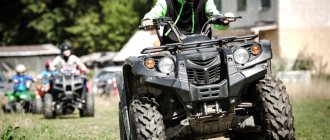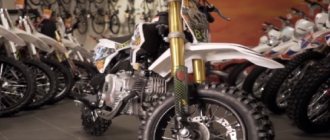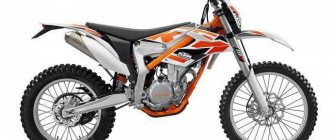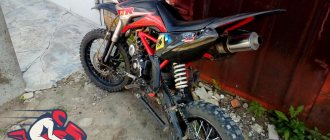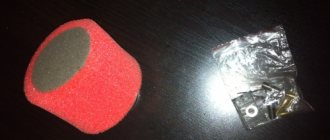A pitbike is a small, lightweight motorcycle that looks like a cross-country off-road unit. It has a 4-stroke engine and wheels with sizes of 10, 12, 14 and 17 inches. They are produced by many motorcycle manufacturers, both world leaders and smaller companies. Today you can buy it in almost every more or less large city from official dealers of companies.
Mini motorcycles of this type are suitable for people weighing up to 100 kg. To make it comfortable to drive, it is equipped with a reinforced frame, extended wheelbase, reinforced suspension, high handlebars, etc. However, it remains an oversized bike, which makes it a real pleasure to ride. The fuel used is 92nd or 93rd grade gasoline, which is simply poured into the gas tank. There is no need to add or mix oil with additives into gasoline, which also simplifies the preparation of the bike for travel and operation.
The main questions are how to ride and where? Country - movement over rough terrain. 10-17-inch wheels with off-road tread are suitable for this. Country skiing is the most popular type of skiing. The main thing is to protect the rider.
Motocross. Any tracks and jumps for riding and jumping are suitable for this. Wheels must be 14/12 or 17/14 inches equipped with off-road tires. All attention is paid to the safety of the rider.
Supermoto involves riding on any flat surface. Karting track or special tracks for Supermoto are perfect for this. Wheels can be 12/12 or 14/14 inches, and Slick tires provide good grip.
Stunt is one of the most popular disciplines. Any area with a smooth, high-quality surface is suitable for it. Involves performing various stunts and basic aerobatics in motorsports. For best results, use pegs and yokes.
The park is a fairly new area that involves tricks and figures. You can ride in Skate and BMX parks, specially created for this purpose. A pit bike in this discipline weighs quite a bit. Wheels with road tires should be 12/12 inches. Motorcycle protection is provided by pegs and sliders.
Freestyle motocross is also a new discipline. These are dizzying jumps from springboards, performing acrobatic stunts in flight. But this is also the most dangerous direction.
Street is driving around the city without rules and restrictions. Various tricks are performed on obstacles. Obstacles include stairs, curbs, walls, cars - any objects protruding or rising above the asphalt. Motorcycle protection is provided with pegs, yokes, and sliders. But this discipline is prohibited because it is dangerous for the drivers themselves and others.
There is a question that interests both the owners of a new pit bike and those who are just planning to buy one: is it dangerous? Riding a minibike is safe if you don’t forget about protection and use common sense rather than passion. If you do the opposite, then not only a motorcycle, but also a bicycle, but also a scooter will become dangerous.
Pitbike has a simple, but at the same time reliable design, the operation of which does not require the driver to have special knowledge or certain skills.
In order for the bike to serve you for a long time and not cause any complaints, you need to properly break it in and monitor the condition of the parts and components. Attention should be paid to the quality of movement from the first ride until the completion of the first 35 motorcycle hours.
During break-in, pay attention to the engine. In order to continue to enjoy a good and fast ride, you first need to be patient. Carefully monitor the oil level in the engine using the dipstick. When checking, the motorcycle must be level, otherwise the indicator will be overestimated or underestimated. Unscrew the dipstick, wipe it with a clean cloth, insert it back without screwing it in, then take it out again and look.
The oil level can also be checked on a “hot engine”. After turning off the engine, you need to wait a couple of minutes and then take measurements.
When running the motorcycle for the first 35 hours, strictly ensure that the engine does not overheat. When starting a cold engine, wait until it warms up (approximately 2 minutes).
To make the run-in as effective as possible, follow the recommendations. Avoid sudden and heavy loads on the engine and clutch. Do not ride for a long time at low speeds, pick up speed smoothly. When changing speeds, avoid jolts and jerks, change gear modes smoothly. On each subsequent trip, if the break-in was done correctly, the gearbox will work more clearly, and gear shifting will become more confident. To ensure the engine lasts longer, the oil should be changed twice during break-in: after 18 and 35 hours of operation.
www.micromoto.ru
Pit bike control
Before riding, review the motorcycle safety section again.
Make sure you know how the mechanism that keeps your motorcycle upright, the kickstand, works. Make sure that flammable materials, such as dry grass and leaves, do not come into contact with the motorcycle exhaust system while the motorcycle is riding, idling, or parked.
1. After the engine has warmed up, the motorcycle is ready to ride. 2. Holding the motorcycle handles with both hands, remove the motorcycle from the stand. 3. Sit on the motorcycle with your feet on the ground. 4. Depress the clutch all the way and engage first gear. 5. Smoothly turn the throttle towards you and gradually release the clutch. The motorcycle will then begin to move. 6. Make sure that the speed you have gained is sufficient for a stable ride, and place your feet on the footrests of the motorcycle. 7. While squeezing the clutch, sequentially shift to higher gears. Switching to a higher gear occurs when the optimal speed is reached.
To slow down or stop, you first need to release the gas a little, and then smoothly press the brake lever and pedal. When braking in an emergency, first depress the clutch and release the gas, and then firmly press the brake lever and pedal. To avoid the motorcycle tipping over, it is always necessary to start braking from the rear wheel.
Braking on wet surfaces is quite difficult. Avoid emergency braking. It may cause the motorcycle to slip and tip over. To stop on a wet surface, you need to apply the brake smoothly.
When making a turn, ease off the gas and apply the brakes to slow down. Letting off the gas and braking suddenly while turning can cause you to lose control of your motorcycle.
When driving on wet or loose roads, all your actions should be smooth. Sudden acceleration or turning may cause loss of control.
Do not overload the motorcycle. Excess weight can lead to loss of balance.
To stop the motorcycle smoothly, you need to release the gas a little, reduce the speed, squeeze the clutch and smoothly press the brakes. Engage neutral gear. Turn off the ignition and lock the steering wheel. After this, place the motorcycle on a stand. Before your rides, we recommend that you choose and buy an insurance policy online:
How to change gears on a motorcycle correctly
All movements you make with the pedals must be smooth so as not to damage the transmission.
When changing gears, change one speed at a time. It is not advisable to jump.
To understand how to change gears on a motorcycle, you need to carefully study the controls. There are motorcycles with manual transmission and semi-automatic.
Gear shifting methods
Method one
Motorcycles with manual transmission. All actions in this case occur in the following sequence. Pick up speed. Take off the gas. Engage the clutch. Press the gear shift pedal. Release the clutch, then the shift pedal and add gas.
To start the motorcycle, place it in neutral. After this, remove the gas and squeeze the clutch, at the same time turning on first gear. Taking your foot off the gear pedal, apply gas and release the clutch. Now add gas.
To upshift, you need to lift the gas, engage the clutch and press the gearshift pedal. After this, release the clutch, release the shift pedal and add gas.
To downshift, you need to remove the gas and engage the clutch. After this, sharply add gas, and when the speed begins to drop, press the gearshift pedal. Release the clutch and shift pedal and add gas. Once the motorcycle has stopped, be sure to put it in neutral.
Method two
Motorcycles with semi-automatic transmission. On these motorcycles, gear shifting is easier. Take off the gas and change gears. The clutch and gearbox are connected here.
Before starting the engine, place your bike in neutral. In order to engage first gear, you need to remove the gas and press the gear lever down. To increase the gear, you need to remove the gas and lift the gear lever up. To downshift, on the contrary, you need to apply gas and immediately remove your hand from the gas. When the speed starts to drop, change the speed and add gas. Now you know how to change gears on a motorcycle.
Preparation
An important parameter for success in shifting gears is the speed and accuracy with which you shift, so you need to carefully consider the issue of convenient location of the clutch lever and the height of the gearbox foot. Both parameters depend entirely on your riding position and may change as you gain experience riding the motorcycle. The fingers of your left hand should not rest on the clutch lever, you should touch the lever only when changing gear, the rest of the time your hand should clasp the steering wheel clip. You must choose the angle of the clutch lever and its lift in such a way that you can reach the lever at any time and nothing will interfere with you. You need to pull the clutch lever with four fingers. Pay attention to this. It is not recommended to install shortened bicycle-type handles under two fingers.
- the lift of the lever is too large, there are times when you need to grab the steering wheel to reach the lever and this can only be done with your fingertips;
- The angle of the lever is such that it is not possible to reach the lever in all situations.
Balance
If you know how to ride a bike, consider yourself lucky. You've probably heard the phrase, “It's like riding a bike,” when faced with a new and difficult task. But once they understood the principle of operation, they could easily cope with anything.
The only difference when learning to ride a motocross motorcycle is the weight and speed of the machine. Don't expect to be comfortable right away.
Beginner riders usually sit rather than stand, because it’s easier. But you will learn to balance faster if you move while standing.
Compliance with this rule will prevent any dangerous situation, since in the stance the overall center of gravity increases, and when landing it decreases.
To summarize: to maintain balance during technically difficult riding, and simply to maintain the balance of the motorcycle, you must be able to ride while standing on the pegs.
How to develop a sense of balance when learning to ride standing?
There is a good exercise for this:
- Find a large parking lot and try to drive standing as slowly as possible. Try to come to a complete stop while standing on the footrests and then accelerate again without your feet touching the ground.
- Feel with your feet almost imperceptible changes in the inclination of the pit bike in the longitudinal or transverse planes, as well as changes in the surface profile.
- Body position is critical to maintaining balance, especially when the rider is turning, jumping or landing. In these cases, body lean is critical in preventing loss of motorcycle control and reducing fatigue.
Remember, incorrect body position when riding a bike leads to falls. If you watched motocross on TV, you probably noticed that on sharp turns the rider and pit bike are almost parallel to the ground, while the pilot does not deviate anywhere.
Such tricks require constant training.
Start
The most difficult element for a beginner motorcyclist. Shift the gearbox to neutral. Make sure your elbows are bent and your center of gravity is forward. Depress the clutch. Engage first gear. From idle speed, smoothly release the clutch handle while raising the speed. If your motorcycle is equipped with a clutch lever position sensor (for example, Suzuki fuel-injected motorcycles), then you may notice how when starting from neutral the motorcycle itself adds speed - making it easier to start. Do not drop the clutch lever. Once you have mastered the soft start, you can learn to start faster. The principle of a fast start is the same as for a slow one - you load the front, your arms are bent, but the start does not start from idle speed, but from rpm from 4000 to 8000. The optimal start for a beginner in the city is to start from 3000 rpm. When starting, we recommend keeping your right foot on the rear brake - if you miscalculated the speed and the motorcycle begins to climb onto the rear wheel, use the rear brake. Often, we start where we end. Traction control when starting a motorcycle, using the rear brake, is widely used by riders when starting a motorcycle in world championships.
What is the benchmark - what is the fastest start. The fastest start is when you lie on the tank and throughout the entire acceleration line your wheel is torn off by 0.5 - 1 cm from the ground level. Taking into account bumps, this element is quite complex and, often, for its practical implementation, electronics are installed in motorcycles that control the unloading of the front wheel. On motorcycles equipped with a quick start, you can start with the throttle fully open; the electronics analyze the load on the front fork and automatically turn off the ignition as the fork becomes too unloaded. From the pilot's point of view, it looks like this: you load the front, lie down on the tank, fully unscrew the throttle and practically drop the clutch - the electronics do the rest. 99% of motorcycles are not equipped with a quick start and the pilot has to do the electronic work.
The main criterion for a successful start in the city is constant engine speed as the clutch releases. As you release the clutch, the revs begin to drop and you should try to keep the engine revs constant by opening the throttle at the same time as releasing the clutch. If you managed to do this, you can move on to the next step - reducing the clutch release time. After this exercise has begun to work out, try starting at high speeds, loading the front.
The problem with rights
The legislation does not equate pit bikes to any category of vehicles. Consequently, it is impossible to obtain rights to them. It is also impossible to issue a registration certificate for this type of motorcycle.
However, these conditions apply to low-power models. Today, competent tuning allows you to accelerate motorcycles to 200 cm3. And the law is stricter for such vehicles. To drive a powerful pit bike, you will need a license - PTS. In general, the algorithm that allows the operation of such equipment legally is as follows:
- Obtaining category “A” license (for motorcycles). They are issued at the age of 18, but you can go to a driving school at 14.
- Registering a pit bike with the regional traffic police department.
However, it is impossible to obtain a technical passport. Therefore, you will need to ride a pit bike away from public roads. In any case, in order to prevent possible problems with control, it is better to enroll the child (if the motorcycle is intended for teenagers and schoolchildren) in a driving school. There, under the supervision of teachers, he will learn the basics of driving a pit bike.
This type of motorcycle is quite easy to operate and is essentially not much different from a motorcycle. However, many are interested not only in the driving principle itself, but also in the ability to perform spectacular stunts. On pit bikes this is real. Moreover, this type of vehicle is successfully used when performing in sports disciplines where acrobatic techniques are common.
Shifting up gears with clutch
To understand the upshift technique, perform the following experiment. Drive in second gear with the throttle slightly turned off. Now, without closing the gas handle - squeeze the clutch - you will see how the revolutions instantly rise. Close the throttle. When the load in the form of the rear wheel disappears, nothing prevents the engine from spinning up and the speed increases rapidly. That is why speed in gear shifting plays an important role. If you shift quickly, then you may not close the throttle; at the moment when the clutch is depressed, the speed rises and immediately the gear shifts up and the clutch returns. If you do this quickly, then the revolutions rise by only 1000-1500 to provide optimal conditions for upshifting with the clutch.
To change gears up with the clutch, you need to quickly squeeze the clutch, shift up and release the clutch so that the revolutions at which the next gear is engaged do not exceed the revolutions of the gear from which you are shifting by more than 1500. If you do this slowly, you need to close the throttle at the moment when the clutch is depressed, if quickly, you can hold the handle in the same position or barely close the handle. An important criterion is the speed at which you started shifting up and the difference between the speed at which you depressed the clutch and at which you released the clutch - the difference should not exceed 1000 - 1500 revolutions. With practice, gear shifting will become automatic and will not require attention.
How to change gears on a motorcycle
Most motorcycles are equipped with a sequential gearbox. Therefore, the basic principles of all actions are similar.
Gear shifting on a motorcycle differs between “up” and “down”. The first one means you need to shift into a higher gear. To do this, you engage first gear, and thus increase the speed of the motorcycle, and then gradually switch to the next gear in the following sequence:
- Quickly release the gas, engine speed decreases. At the same time, press the clutch lever.
- Shift into the next gear.
- The clutch needs to be released; At the same time, add gas and increase the speed.
Any gear change to a higher gear occurs in this sequence.
To engage a low gear, use the downshift. This is done when it is necessary to increase the power of the rear wheel, for example, when going uphill. What is the sequence of actions in this case?
- You let off the gas.
- Press the clutch lever.
- Now you need to engage a low gear.
- Release the clutch.
- And at the same time, quickly add gas.
If you want to slow down or stop the motorcycle, you must release the gas before you press the clutch. Brake until you shift from first to second gear.
Sequence of actions when starting off:
- take the correct landing;
- depress the clutch;
- engage 1st gear;
- increase the gas a little;
- slowly release the clutch;
- Adjust the speed only with the throttle handle.
RPM at which you shift
You should shift up in the high rpm zone (cut-off rpm minus 4000). If you shift at low speeds, then you may need a larger throttle shift - 2000/3000. The technique for shifting at high speeds is the same for all motorcycles and displacements. The technique of switching at low speeds varies depending on the engine size by throttling. At low volumes, when switching at low speeds, more throttle is required than at large volumes. Shifting at low speeds is not correct.
Is it possible to ride a pit bike on the roads?
No. Since a pit bike is nothing more than a sports tool, you cannot ride it on public roads. Moreover, this applies not only to streets, highways and asphalt roads in general. According to traffic rules, a road is any surface equipped or adapted for driving. That is, a country road, simply trampled by cars - all this also applies to roads.
Shifting without clutch
The motorcycle gearbox is designed in such a way that it allows you to shift up without a clutch at any speed. One way to shift up gears without a clutch is to briefly reduce traction using the throttle. You need to quickly close and open the throttle and at the same time push the gear shifter up. If you do this at the same time and quickly, the box will shift up without using the clutch. Another way is to use a quick switching device; a sensor connected to the ignition control unit is installed in the break of the switching foot rod. During an upshift, the rod presses on the sensor, the sensor transmits a command to the ignition control unit, and the unit turns off the ignition for a pre-programmed time depending on the engine speed (usually no more than 50 milliseconds), the motorcycle’s thrust drops and the box clicks up.
What else is worth remembering?
Before you start riding a dirt bike, fear has a huge influence. The thrill of riding a 100-kilogram two-wheeled car that can accelerate to more than 80 km/h is a tasty lure for some. But for others, accidents, falls and serious injuries kill all interest and possible pleasure.
Fear is not always easy to overcome. Analysis and analysis of the mistakes of more experienced riders who have already overcome the path that you have yet to travel will help you cope with it. This will speed up both the time and efficiency of mastering motorcycle riding skills, and will also reduce the likelihood of getting into an accident.
And the last piece of advice is for those who plan to participate in competitions. All the previous tips will be useless to you if you lose faith in yourself even before the start of the race.
Never think about those who are better than you. Other drivers may have the latest shiny bikes with cool graphics, but that doesn't give them any advantage. The psychological attitude is what is truly important, especially if it is supported by your proven driving technique.
Switch down
In order to understand what you should be wary of when shifting down, do a simple exercise: accelerate in second gear and completely close the throttle, while braking the engine, depress the clutch and roll with the clutch depressed, you will see that the engine speed will drop to idle, now, if you release the clutch there will be a sharp push, up to the temporary blocking of the rear wheel - the motorcycle will try to spin the engine from idle speed to the speed at which the motorcycle is currently moving. If you raise the speed when you release the clutch, the push will be less noticeable, and if the engine speed matches the speed at which the motorcycle is moving in second gear, there will be no jerk at all.
When you shift down, you must either do it quickly with the throttle closed in order to prevent the engine speed from dropping, or use over-throttle - i.e. add gas when shifting down.
So - quickly depress the clutch, quickly click the gear down - quickly release the clutch. If you do it slowly, we recommend using over-throttle - i.e. at the moment when the clutch is depressed and the speed begins to drop to idle speed - briefly, sharply raise the speed and, shifting down, release the clutch. The goal is that the rpm at which the lower gear is engaged should be either the same or 1500 higher than the rpm at which you shift.
All motorcycle speeds and its maximum speed
The maximum speed of a motorcycle depends on the power of the bike and the drive gear ratios. Motorcycles of different sizes can reach speeds from one hundred and forty kilometers to three hundred and forty kilometers per hour.
You don't need to make your bike's top speed an end in itself. Much more important is how dynamic your motorcycle is at all possible speeds. Gear ratios can be increased or decreased to improve the motorcycle's performance. For example, for city streets the maximum speed is not higher than 220 km/h. In this case, the gear ratios are selected so that at this speed the sixth gear is turned into the cutoff. The motorcycle will gain such important dynamics for it.
For track racing, the gear ratios are chosen slightly differently so that all six gears are used until a top speed of 280 kilometers per hour is achieved.
Replacing gear ratios is considered the cheapest tuning and does not affect the wear of the motorcycle.
www.motoking.ru
I quote Misha17:
“Tearing the box” is an interesting term.





